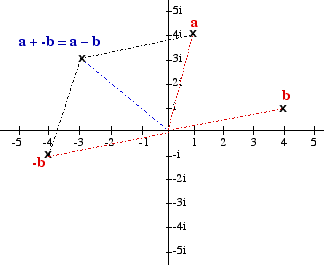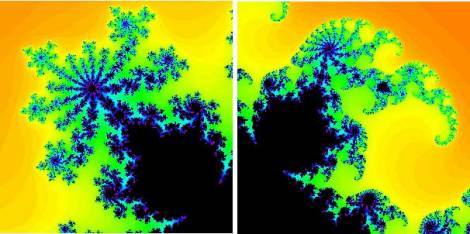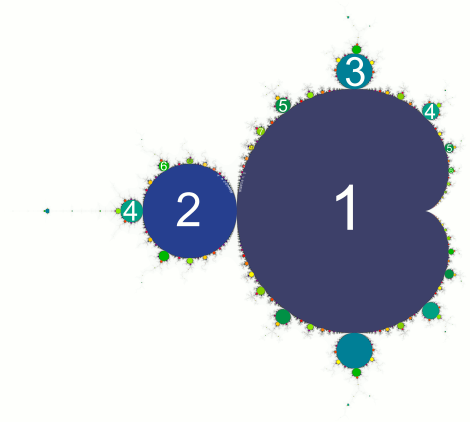I have previously authored a post on mathematical beauty, which as we know here at RTU is one of the purest forms a human can revel in. Today I intend to present an elegant piece of mathematics which through it’s simplicity can give insight into seemingly disordered systems, along with producing imagery that looks more like a magic eye that mathematics. The skills required are reasonably elementary until the final stages, where we take a little more care to define the concept of a complex number. A minimal comprehension in this area is required, and will be contained within the post.
The beginnings
In mathematics (or any other walk of life I assume) an iterative process is one which is repeated. If I do my process 4 times, I can say that I have done 4 iterations for example – the point is I have repeated the same process four times. We can express iterative processes as very simple expressions. Say for example my process was to take a number, then add 2 to the number with each iteration. In order to express this mathematically I would write:
x1 = x0 + 2
What I am saying here is that the next term in the series, which here is x subscript 1 is simply the previous term (x subscript 0) plus 2. Now I could write the next term as:
x2 = x1 + 2
but really you didn’t need this information – you have all the information you need from the first expression and can iterate away as many times as you like – there is no limit, your time is your own. There is of course no explicit advantage to expressing these things things as formulas, we can communicate the same information with words, there is just an efficiency benefit since as the expressions become more complex words become unwieldy, while mathematical expressions stay more compact. It also means if someone is reading this blog for example who speaks no word of English, but is a mathematician they will be able to tell you that I have used one hell of a lot of words to talk about the iterative process of adding 2 to a number, in their mother tongue.
We need to briefly discuss sets, before we proceed to the Mandelbrot. A set is a collection of objects, or in this case numbers that has some rule which defines if they should be inside or outside of the set. Generally a set is enclosed in curly brackets; as a basic example I might write {1,3,7,23,51}. There is no real logic to this, but if I give you any number one can quickly tell from inspection if an item is inside or outside the set – 1 is inside, 2 is outside. A slightly more fanciful set might look like A = {a ε ℝ : a > 4} . This looks wonderful, but reading left to right all this says is the set A is defined as the set equal to all real numbers greater than 4. Clearly we had to use more powerful notation here, since this set has an open upper bound and we could not have listed out all the elements.
Mandelbrot sets curiously involve a function no more complicated than the types taught at GCSE grade – but don’t beat yourself up if you are rusty! We consider the functions of the form
f(x) = x2 + c
Where c is a constant. Now this function can be altered lightly to make a series of iterations like we had before –
x1 = x02 + c
x2 = x12 + c
and so on, where I take the previous number, square it and add my constant. If I asked you to write me out 100 iterations – hopefully you would ask me for two things – the value of c and the value of x0. The value of x0 is of great importance, so it will have a special name – the seed, for it is the seed which will drive the growth. The value of the constant is also of tremendous importance for Mandelbrot sets, although depending on the relationship with the seed in some examples it is quite trivial.
A few Mandelbrots
I want to present a few very basic sets for simple values of c and x0 before going on to bigger things. Say for example I take my constant to be 0, and my seed to be 1. Then I have a very boring set indeed! The first term is 1² + 0, so 1. Then the next term is the previous term squared plus 0 – uh oh, looks like I’m stuck in a loop. So by taking these values I have the set {1}. If I had of let c equal zero as before, but let my seed also take the value of zero I would of had the most boring set of all – the set {0}. Moving on to something slightly more interesting – see if it follows to you that if we let c equal 0 and we have our seed as -1, we get the set {-1,1}.
If I take less trivial values, say for example letting the seed and the constant take the value of 1 then hopefully it is clear to see this thing will blow up pretty quickly – the first term will be a nice sensible 2, then a manageable 5, followed by 26 and we are off – the next term is 677 and the one after that into the hundreds of thousands. This is because, if my seed and constant allow the squared term to dominate the growth is explosive giving a set where the terms quickly get larger. Unlike the other sets we discussed, this one is infinite in size. Interestingly when we put in different values the system tends to different behavior. If for example we hold our seed at 0, then a value of c equal to -1.6 gives us chaotic behavior however a value of c equal to -1.75 gives us a repeating pattern with a period of 3 – this is by no means intuitive. It is the changing nature of the sets relative to a seed of zero that interests us today.
Getting complex
I need you to make a conceptual leap and consider complex numbers. We won’t learn about them in full, but let me tell you a few facts about them. A complex number has a real and imaginary element to it – the real part is the bit you are comfortable with, the ordinary numbers. The imaginary element is just another number added to the real element and denoted i. It is worth knowing that i² is equal to -1, so these numbers are very hand as we can square root negative numbers.
You might think this sounds totally made up – and if you do feel that way you are correct, however what is spooky about complex numbers is that the addition of the imaginary element allows us to model and solve real world problems. So can we really say they are imaginary when they solve things which are real? Or can we say the things are real when they are solved by numbers which are imaginary? One for another day.
Rather than representing complex numbers in a line, like we would ordinary numbers we are required to introduce an additional axis – we have two number lines, at 90 degrees to each-other with one representing the complex numbers and one representing the real numbers. Because the complex numbers occupy all of this space we say the complex numbers are represented in the complex plane – this isn’t anything technical, it’s just a result of the fact that we can plot all the real numbers on a line but we need an area, or a plane for the complex numbers. Here are a few complex numbers plotted in the complex plane.

So here we have the number represented by a as 1 + 4i; 1 being the real part and 4i being the imaginary part we just introduced. Lovely.
The Mandelbrot we love
Now we have battled through all that maths we can finally produce something artistic! Now earlier we discussed a seed of 0, and we highlighted the fact that when the value of c takes different values we have different options;
- We have a null set, when c =0;
- We have a finite set, when c takes certain values possibly following a repeating pattern; or
- We have a set which tends to infinity.
The Mandelbrot set is interested in the entire complex plane – so to give you a few examples if I let c = i and my seed as zero, I have;
x0 = 0x1 = 02 + i = ix2 = i2 + i = -1 + i
This set does not escape to infinity it stays locked up with fairly small values. There are many sets for which this happens – and many for which it does not. We want to be able to “see” this.
A visual representation of the Mandelbrot set is interested in considering the values within the complex plane where I can have this phenomena – if I let my seed equal zero, what values of c will give me a finite set. This is the result.

The black areas indicate the regions where this is possible, with the areas outside being values which tend to infinity.So any area within the black represents a value of c, with a seed of zero which produces a finite set. It should be clear this is a highly intricate pattern from this very zoomed out image, but what happens when we zoom in closer is truly breathtaking. Have a look at this zoomed in image.

What is most interesting is that the more we zoom in on these boundaries, they still look just as crinkly. The detail is almost beyond comprehension! The main heart of the Mandelbrot is decorated finely with bulbs and antenna all different in shape – the nature of these crinkles is one of the big problems still open in mathematics today.
There are however many interesting things we do know. For example, if we choose any number within a bulb of the Mandelbrot we will know the period the pattern tends towards. This is shown here – so for example if my c value is in the area labeled 3, then my iterations tend to the same value with each 3 goes.

The conclusions we can draw from these sets is an underlying order among chaos. We are using geometry to understand the dynamics of the function, and using the dynamical information to understand the shape of the geometry – this is a big leap forwards in human thought. Whilst this interplay is not fully understood, it has fundamentally shaped the way we look at the world. Benoit Mandelbrot once said;
“Clouds are not spheres, mountains are not cones, coastlines are not circles, and bark is not smooth, nor does lightning travel in a straight line.”
This roughness, or chaos in the world is something Mandelbrot celebrated – and in fact on a small scale these chaotic things are similar to the overall larger things. Small clouds for example is very similar to the overall thing; allowing some logic and unity to be applied. This is the very heart of fractals and has found successful application in the fields of cosmology, medicine, engineering, genetics, art and music. The discoveries into this area are relatively new, due to the fact that they required computers for the powerful visualizations – something Mandelbrot had access to while working at IBM. There is a particularly interesting application he was able to use; through fractals he could accurately predict profits and losses made by traders over time. In 2005 he warned that traders have a tendency to act as if the market is predictable and immune to large swings; something we may well argue was vindicated a few years later. This is truly a powerful area of mathematics, which through comprehension can only deepen the human need to bring structure to chaos.
Finally, in case you need it:
-
a curve or geometrical figure, each part of which has the same statistical character as the whole. They are useful in modelling structures (such as snowflakes) in which similar patterns recur at progressively smaller scales, and in describing partly random or chaotic phenomena such as crystal growth and galaxy formation.
A big thank you to all our followers, new and old. This is post 100 here at RTU.

I dont understand half this stuff… And It think mankind only maybe know .01% about the universe and how it really works. Congrats on your 100th post!
LikeLiked by 1 person
Thank you very much! They are incredibly complex areas, and I think if you can understand 0.1% and enjoy it, then it is very worthwhile indeed!
LikeLiked by 1 person
Very complex… If you watched the film Dr Stange.I tend to think it is that complex..or even more..but yeah one dont have to understand 100% to enjoy it! is fascinating indeed!
LikeLike
I have seen the film! Really enjoyed it, and yes I totally agree – this is what this site is all about, showing you can be fascinated by these subjects without spending years studying the finer details
LikeLiked by 1 person
Hearty congratulations on reaching 100. On scanning thru’ I espied perhaps a highly significant remark, “The conclusions we can draw from these sets is an underlying order among chaos”. Look forward to digesting the whole piece at leisure over lunch today!
LikeLiked by 1 person
Thank you very much indeed! I am glad the post has caught your eye – I hope you enjoy over lunch!
LikeLiked by 1 person
“Mandelbrot” are also a kind of twice-baked almond flavored cookie (similar to biscotti) that are delicious dunked in tea or coffee.
LikeLiked by 2 people
I am not sure which of the two is more delicious!
LikeLiked by 2 people
well that’s new to me… But I totally enjoy it.
LikeLiked by 1 person
Thank you for reading!
LikeLiked by 1 person
Thanks for your explanation. I remember trying to read Mandelbrot’s early paper on fractals (How long is the coastline of Britain?) in Science decades ago and only vaguely comprehended bits of it. Your explanation makes more sense to me as a layman.
LikeLike
Thank you very much for reading and I am so glad you found it easy to follow! That is always my aim
LikeLike
I lost all comprehension of everything mathematics at the age of 12. Resultantly I didn’t understand a word after you began explaining Mandelbrot. But what you said before, iterations and how an equation is more adept at conveying something than words twice as numerous made perfect sense to me. That mathematics could be language in itself is a revelation to me,and I must thank you for showing me that.
LikeLiked by 1 person
I am glad you were able to take something away from it! It really is a tough subject to comprehend but thank you for reading
LikeLiked by 1 person
Yes, I’m glad I did persevere even though my mind kept telling me ‘this is beyond you’. Once again thank you for this post 😊
LikeLiked by 1 person
Nice article! When seed and c are both zeroes the resulting set is {0}. Why is this called a null set?
LikeLiked by 1 person
Sorry that was my slip of wording – I have amended. It is the zero set, I did not mean null set. There is only one null set with a cardinality of zero
LikeLiked by 1 person
Thanks for the clarification!
LikeLiked by 1 person
Thanks, Joseph. On the “visual” side of Madelbrot and fractal, I would recommend a quick tour of this site @http://mandelbulb.com/
Mathematics (and good coding) expanded the artistic discourse in many unexpected ways.
LikeLiked by 1 person
Wow! That website is wonderful thank you very much for the link. I will look forward to exploring this more
LikeLiked by 1 person
hey, check out my blog! think it might interest you!
LikeLike
I like your article, very inspiring and thank you for post
LikeLike
I’m fascinated by the maths behind the Mandelbrot set. I first came across its working out in Penrose’s The Emperor’s New Mind, reprised in his later book The Road to Reality. Mandelbrot hadn’t even discovered it when I was at school (I’m sort of giving away my age, aren’t I?)
LikeLike
Thank you very much for your comment! I am glad you share the same love of the Mandelbrot set – it truly is top level mathematics. I wouldn’t look on that as a negative, more as a sign of how far mathematics has come in a short space of time!
LikeLiked by 1 person
It surely has – as has science in general.
LikeLiked by 1 person
Very cool. I love seeing amazing mathematical structures that come out in nature as well. Math truly is the universal language.
LikeLiked by 2 people
Thank you very much for your comment – I totally agree, I still find it spooky when you see how deeply rooted mathematics is in nature
LikeLike
I wish I understood….
LikeLike
As do we all! It’s an area with a lot left to learn
LikeLiked by 1 person
I have nominated you for Blogger Recognition Award. I love all of your posts so much! I hope you will accept this award. For more information, please see my post – https://jyotiskitchenblog.wordpress.com/2017/02/17/blogger-recognition-award/
LikeLiked by 1 person
Good morning. I enjoyed your piece and, while it was probably the most mundane part, I found interesting the definition of a fractal — something I’d never looked up. It’s giving me some context for my own work (hexspin.com). Thanks!
LikeLiked by 1 person
I am glad that some of the post reached out to you – each part is just as important! Thank you for reading
LikeLiked by 2 people
Would you please take a little of your time to look at these numbers?
I spent a few months adding, substracting, dividing, etc…. I’ve searched the periodic table, distances between galaxies, I even thought they were a sequence such as the fibonacci’s and many more but I haven’t figured out anything. They might be random numbers, I really don’t know. That’s why I thought that as a mathematician you might have LOTS of ideas which will never cross my mind. So would you please tell me if you find anything, or even if it’s nothing.
1, 30, 40
1, 30, 40, 90
1, 30, 200
1, 30, 40, 200
20, 5, 10, 70, 90
9, 5
9, 60, 40
9, 60
10, 60
90
8, 40
70, 60, 100
100
50
Each set is made of 1 to 5 numbers, they might be connected or not.
Thanks
Kind regards
LikeLiked by 2 people
Let me come back to you on this – seems curious
LikeLiked by 2 people
Would you please specify what seems curious except the fact that I have no clue what is it all about? Do you mean that you haven’t figured out anything? Or do you mean that we need a “key” to unlock it? Or what?
Sorry to ask many questions at once.
LikeLiked by 1 person
Perhaps you could give me a little more information about the origins of these numbers? Context is often very useful in illuminating patterns. I have not had time to look over them in full yet, but if you believe there to be a link I shall do my best to find it!
LikeLiked by 2 people
I thank you for that, you may take a look at the new post, the overall issue is the example at the bottom.
Kind Regards
LikeLiked by 1 person
So, did you find anything useful for those numbers so far?
LikeLike
Nothing immediately jumps out by I couldn’t actually locate the post you referred to where you talk about their origins… could you send me a link?
LikeLiked by 1 person
This is the link https://wordpress.com/post/novuslectio.wordpress.com/1296
The example I’ve given in that post is actually the real issue, I suppose you know that letters have their own value numbers, so those numbers are these values.
Thanks
LikeLike
I suppose nothing jumped out yet?
Do you have any other idea that I may search in?
LikeLike
Pingback: In lumina·
I love the Mandelbrot sets and Fractals. I have to restrain myself from making all my blog posts about them haha!
LikeLiked by 1 person
A challenge indeed! I know exactly what you mean, I think they are a very powerful area of mathematics which we have a huge deal to gain from yet
LikeLiked by 2 people
Nice. Thanks Joseph. This reminds me of generating Mandelbrot and Julia sets (and Lorenz attractors, …) on my Amiga in the 90s. So much faster nowadays. 🙂
LikeLike
So much faster indeed! I am glad you enjoyed
LikeLike
Howdy! Do you use Twitter? I’d like to follow you if that would be okay. I’m absolutely enjoying your blog and look forward to new updates.
LikeLike
Hey! We sure do, you can find us at @rationalisingtu
LikeLike